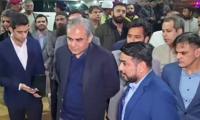Liberia’s presidential election of 1927 saw incumbent president Charles King garnering 234,000 against 9,000 votes. It would have been a remarkable victory but for a glaring faux pas. At that time, Liberia had only 15,000 eligible voters. The Guinness Book of World Records recognized it as the most quantitatively fraudulent election in recorded history.
Voters are the biggest stakeholders in any democracy. Elections are not merely an arena to decide victory or defeat. They are a crucible to reward or reject a candidate for his record of public service. Nothing can be a greater affront to the people than an election being viewed as a manipulation-prone conduit to the corridors of power.
The recent election in Pakistan, held beyond the mandated 90 days, saw internet outage, vanishing staff, delay in results and Forms 45 and 47 allegedly citing different winners. The unwarranted delays in forming election tribunals add to what is already a lethal concoction. This election has been derided by political parties, independent analysts and bodies, foreign diplomats and the US Congress.
Right across the border, India’s election history too was far from exemplary. That is before one man, Tirunellai Narayana Iyer Seshan aka TN Seshan, cleaned up India’s electoral system. In 1990, prime minister Chandra Shekhar appointed him as India’s 10th chief election commissioner (CEC).
Seshan’s autobiography, ‘Through the Broken Glass’, reads: “I assumed office not knowing how the EC worked. I had never conducted an election. I went with two principles -- zero delay and zero deficiency.” He adds: “It was not that I introduced a new reform in the system. In fact, I didn’t even add one comma, semicolon or a full stop to the (election) Act. Whatever was said in the Act, I implemented.”
Seshan started his six-year tenure by identifying over 100 common electoral malpractices including inaccurate election rolls, coercion, exceeding election spending limits, delimitation manipulations and abuse of authority. Starting the cleanup from the EC, Seshan ordered no bribing or intimidation of voters, no use of official machinery and made photo ID cards mandatory for voters.
He also initiated the placement of election observers as the eyes and ears of the Election Commission of India (ECI). Dubbed by his detractors as a megalomaniac with autocratic tendencies, Seshan zealously strove to keep the ECI impervious to pressure from any quarter and ensure free and fair elections. Having achieved that, he is credited with playing a major part in the evolution of India’s democracy.
Continuing to uphold the bar set up by him, what could be a more befitting tribute to Seshan’s legacy than India’s recently held election over a grueling six-week period in extreme heat? The ECI set up 1.05 million polling booths with 5.5 million electronic voting machines (EVMs) for 969 million registered voters. 1.8 million Voter-Verifiable Paper Audit Trail systems were also deployed to confirm that the EVM-aided vote was cast properly.
Each institution played its obligatory part in this mammoth process that involved 1800 observers, 400,000 vehicles, 1,700 air sorties and 135 trains moving across the country to help the deployed 15 million polling officials and security staff. A 66 per cent voter turnout had a record-breaking 642 million voters cast their ballots including 3.7 million postal ones.
The dedication of the ECI staff can be gauged from the fact that its officials trekked 39 km to the remote Malogam village in Arunachal Pradesh. This was to collect the vote from a single polling booth specially set up for 44-year-old Sokela Tayang, Malogam’s lone registered voter.
The seemingly indomitable Modi entered the election fray declaring “Ab ki baar, 400 paar.” Vying for 400 seats to bring in self-serving constitutional changes, he ended up with 240, not even enough to form a government alone.
As Rajiv Kumar, India’s CEC, put it: “Parinaam mein hi pramaan hai” [the result is the proof]. This result with the scale and execution of this election is a testament to the professionalism and impartiality Seshan inculcated in the ECI, now recognized as one of the most able electoral regulatory bodies in the world.
Here in Pakistan, after quite a few legal reversals, the Supreme Court full bench in the SIC reserved seat case unanimously blamed the ECP for “misinterpreting” its judgment regarding the PTI’s election symbol. This resulted in a domino effect imbroglio which was the last thing Pakistan needed. The ECP’s performance was also laid bare by two recent SC verdicts.
Regarding the ECP’s decision to postpone the Punjab elections, the SC declared it was “unconstitutional, without lawful authority or jurisdiction, of no legal effect and is hereby quashed.” The ECP’s order regarding SIC’s reserved seats was judged as “beyond the powers of the constitution, without lawful authority and of no legal effect.” There could not have been a starker indictment of the ECP.
Any institution’s autonomy can only be maintained if it remains subservient to the constitution. Averse to reforms, our election process has always been deeply flawed. Over the decades, people have been blatantly denied their constitutional right to fair representation.
Seshan famously said: “Good government is not an accident.” He made sure that India would only be ruled by those voted in by the people in a free and impartial election. His tenure remains a microcosm of integrity, innovation and resilience. Above all, it is a pinnacle of unwavering commitment to public welfare.
Awarded the Ramon Magsaysay Award in 1996, TN Seshan rightfully earned immense goodwill from the Indian people along with epithets like “the one-day Sultan, the father of electoral reforms and a pillar of India’s democracy.” Can our ECP dare claim even an iota of this?
The writer is a freelance contributor. He can be reached at: miradnanaziz@gmail.com
There are over 11 million Pakistanis settled abroad, out of which around six million work in Gulf and Middle East
This year alone, US Treasury would have to roll-over $10 to $14 trillion in maturing short-term debt
Tear gas no longer marks just protest sites; it paints entire cities as battlegrounds but then again, PTI did it first
Political structures and governance systems have been central to economic and social development
It is confirmed now 40 Pakistanis had died after boat of migrants had capsized in sea near Greece
Many people believe that in future, AI will play an even more significant role in their lives







